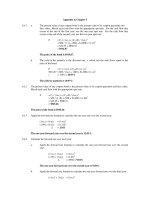Chuong5 3 Chapter 5.3: Network Design
Bạn đang xem bản rút gọn của tài liệu. Xem và tải ngay bản đầy đủ của tài liệu tại đây (886.96 KB, 88 trang )
Chapter 5.3:
Network Design
NGUYỄN CAO ĐẠT
E-mail:
Hochiminh City University Of Technology
Computer Science & Engineering
© 2014
Computer Networks 2
Chapter 5: Network Design
1
Outline
Physical Network Design
Select technologies and devices for
campus networks
Select technologies and devices for
enterprise networks
Testing, Optimizing, and Documenting
the Network Design
Hochiminh City University Of Technology
Computer Science & Engineering
© 2014
Computer Networks 2
Chapter 5: Network Design
2
Selecting Technologies and Devices
We now know what the network will look
like.
We also know what capabilities the network
will need.
We are now ready to start picking out
technologies and devices.
Hochiminh City University Of Technology
Computer Science & Engineering
© 2014
Computer Networks 2
Chapter 5: Network Design
3
Campus Network Design Steps
Develop a cabling plant design
Select the types of cabling
Select the data-link-layer technologies
Select internetworking devices
Hochiminh City University Of Technology
Computer Science & Engineering
© 2014
Computer Networks 2
Chapter 5: Network Design
4
Cabling Plant Design Considerations
Campus and building cabling topologies
The types and lengths of cables between buildings
Within buildings
The location of telecommunications closets and crossconnect rooms
The types and lengths of cables for vertical cabling
between floors
The types and lengths of cables for horizontal cabling
within floors
The types and lengths of cables for work-area cabling
going from telecommunications closets to workstations
Hochiminh City University Of Technology
Computer Science & Engineering
© 2014
Computer Networks 2
Chapter 5: Network Design
5
Centralized Versus Distributed
Cabling Topologies
A centralized cabling scheme terminates most or all
of the cable runs in one area of the design
environment. A star topology is an example of a
centralized system.
A distributed cabling scheme terminates cable runs
throughout the design environment. Ring, bus, and
tree topologies are examples of distributed systems.
Hochiminh City University Of Technology
Computer Science & Engineering
© 2014
Computer Networks 2
Chapter 5: Network Design
6
Centralized Campus Cabling
Building B
Building C
Building D
Cable Bundle
Building A
Hochiminh City University Of Technology
Computer Science & Engineering
© 2014
Computer Networks 2
Chapter 5: Network Design
7
Distributed Campus Cabling
Building B
Building C
Building D
Building A
Hochiminh City University Of Technology
Computer Science & Engineering
© 2014
Computer Networks 2
Chapter 5: Network Design
8
Types of Media Used in Campus Networks
Copper media
Optical media
Wireless media
Hochiminh City University Of Technology
Computer Science & Engineering
© 2014
Computer Networks 2
Chapter 5: Network Design
9
Copper Media
Coaxial
Shielded Twisted-Pair (STP)
Hochiminh City University Of Technology
Computer Science & Engineering
© 2014
Twisted-Pair
Unshielded Twisted-Pair (UTP)
Computer Networks 2
Chapter 5: Network Design
10
Optical Media
Multimode Fiber (MMF)
Hochiminh City University Of Technology
Computer Science & Engineering
© 2014
Single-mode Fiber (SMF)
Computer Networks 2
Chapter 5: Network Design
11
Copper Vs Fiber-Optic Cabling
Twisted-pair and coax cable transmit network
signals in the form of current
Fiber-optic cable transmits network signals in the
form of light
Fiber-optic cable is made of glass
Not susceptible to electromagnetic or radio frequency
interference
Not as susceptible to attenuation, which means longer
cables are possible
Supports very high bandwidth (10 Gbps or greater)
For long distances, fiber costs less than copper
Hochiminh City University Of Technology
Computer Science & Engineering
© 2014
Computer Networks 2
Chapter 5: Network Design
12
Cabling Guidelines
At the access layer use
Copper UTP rated for Category 5 or 5e, unless there is a
good reason not to
To future proof the network
Use 5e instead of 5
Install UTP Category 6 rated cable and terminate the
cable with Cat 5 or 5e connectors
Then only the connectors need to be changed to
move up in speed
In special cases
Use MMF for bandwidth intensive applications
Or install fiber along with the copper
Hochiminh City University Of Technology
Computer Science & Engineering
© 2014
Computer Networks 2
Chapter 5: Network Design
13
Cabling Guidelines
At the distribution layer use
MMF if distance allows
SMF otherwise
Unless unusual circumstances occur and cable
cannot be run, then use a wireless method
To future proof the network
Run both MMF and SMF
Hochiminh City University Of Technology
Computer Science & Engineering
© 2014
Computer Networks 2
Chapter 5: Network Design
14
LAN Technologies
Half-duplex Ethernet (becoming obsolete)
Full-duplex Ethernet
10-Mbps Ethernet (becoming obsolete)
100-Mbps Ethernet
1000-Mbps (1-Gbps or Gigabit) Ethernet
10-Gbps Ethernet
Metro Ethernet
Long Range Ethernet (LRE)
Cisco’s EtherChannel
Hochiminh City University Of Technology
Computer Science & Engineering
© 2014
Computer Networks 2
Chapter 5: Network Design
15
IEEE 802.3 10-Mbps Ethernet
10 Mbps Ethernet
10Base5
10BaseT
Thick coax cable
500 meters
2 pairs
Category-3 or
better UTP
100 meters
10Base2
Thin coax cable
185 meters
Hochiminh City University Of Technology
Computer Science & Engineering
© 2014
10BaseF
2 multimode
optical fibers
10Broad36
3 channels of a
private CATV system
3600 meters
Computer Networks 2
Chapter 5: Network Design
16
IEEE 802.3 100-Mbps Ethernet
100BaseT
100BaseX
100BaseT4
4 pairs
Category-3 or
better UTP
100 meters
100BaseTX
2 pairs
Category-3 or
better UTP
100 meters
100BaseFX
2 pairs Category-5 or
2 multimode optical fibers
better UTP
2000 meters (full duplex)
Hochiminh100
Citymeters
University Of Technology
Computer Science & Engineering
© 2014
100BaseT2
Computer Networks 2
Chapter 5: Network Design
17
IEEE 802.3 Gigabit Ethernet
1000BaseX
1000BaseSX
2 multimode optical fibers
using shortwave laser optics
550 meters
1000BaseLX
2 multimode or single-mode
optical fibers using longwave
laser optics
550 meters multimode, 5000
meters single-mode
Hochiminh City University Of Technology
Computer Science & Engineering
© 2014
1000BaseCX
2 pairs STP
25 meters
1000BaseT
4 pairs Category-5 UTP
100 meters
Computer Networks 2
Chapter 5: Network Design
18
IEEE 802.3 10-Gbps Ethernet
10GBase with Fiber Cabling
10GBaseLX4
10GBaseSR
Multimode or single-mode
optical fibers
300 meters multimode,
10 km single-mode
Hochiminh City University Of Technology
Computer Science & Engineering
© 2014
Multimode optical
fibers
300 meters
10GBaseLR
Single-mode
optical fibers
10 km
10GBaseER
Single-mode
optical fibers
40 km
Computer Networks 2
Chapter 5: Network Design
19
IEEE 802.3 10-Gbps Ethernet
10GBase with Copper Cabling
10GBaseCX4
XAUI 4-lane PCS
15 meters
Hochiminh City University Of Technology
Computer Science & Engineering
© 2014
SFP+ Direct
Attach
Twinax
10 meters
10GBaseT
UTP or STP
100 meters
Computer Networks 2
Chapter 5: Network Design
20
Metro Ethernet
Service offered by providers and carriers
that traditionally had only classic WAN
offerings
The customer can use a standard Ethernet
interface to reach a MAN or WAN
The customer can add bandwidth as needed
with a simple configuration change
Hochiminh City University Of Technology
Computer Science & Engineering
© 2014
Computer Networks 2
Chapter 5: Network Design
21
Long-Reach Ethernet
Enables the use of Ethernet over existing,
unconditioned, voice-grade copper twistedpair cabling
Used to connect buildings and rooms within
buildings
Rural areas
Old cities where upgrading cabling is impractical
Multi-unit structures such as hotels, apartment
complexes, business complexes, and government
agencies
Hochiminh City University Of Technology
Computer Science & Engineering
© 2014
Computer Networks 2
Chapter 5: Network Design
22
Internetworking Devices for
Campus Networks
Switches
Routers
Wireless access points
Wireless bridges
Hochiminh City University Of Technology
Computer Science & Engineering
© 2014
Computer Networks 2
Chapter 5: Network Design
23
Selection Criteria for
Internetworking Devices
The number of ports
Processing speed
The amount of memory
Latency when device relays data
Throughput when device relays data
LAN and WAN technologies supported
Media supported
Hochiminh City University Of Technology
Computer Science & Engineering
© 2014
Computer Networks 2
Chapter 5: Network Design
24
More Selection Criteria for
Internetworking Devices
Cost
Ease of configuration and management
MTBF and MTTR
Support for hot-swappable components
Support for redundant power supplies
Quality of technical support, documentation,
and training
Etc.
Hochiminh City University Of Technology
Computer Science & Engineering
© 2014
Computer Networks 2
Chapter 5: Network Design
25









